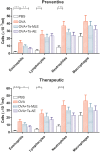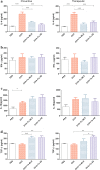Preventive and therapeutic effects of Trichinella spiralis adult extracts on allergic inflammation in an experimental asthma mouse model
- PMID: 31253164
- PMCID: PMC6599242
- DOI: 10.1186/s13071-019-3561-1
Preventive and therapeutic effects of Trichinella spiralis adult extracts on allergic inflammation in an experimental asthma mouse model
Abstract
Background: Helminths immunomodulate the host immune system by secreting proteins to create an inhibitory environment as a strategy for survival in the host. As a bystander effect, this balances the host immune system to reduce hypersensitivity to allergens or autoantigens. Based on this, helminth therapy has been used to treat some allergic or autoimmune diseases. As a tissue-dwelling helminth, Trichinella spiralis infection has been identified to have strong immunomodulatory effects; the effective components in the worm have not yet been identified.
Methods: The soluble extracts of T. spiralis adult worms and muscle larvae were used to treat airway inflammation before and after an ovalbumin (OVA)-sensitization/challenge in an OVA-induced asthma mouse model. The therapeutic effects were observed by measuring the level of inflammation in the lungs.
Results: The soluble products derived from T. spiralis parasites, especially from adult worms, were able to ameliorate OVA-induced airway inflammatory responses which were associated with reduced eosinophil infiltration, OVA-specific IgE, Th2 cytokine IL-4, and increased IL-10 and TGF-β. The stimulation of the Treg response may contribute to the alleviated allergic inflammation.
Conclusions: Trichinella spiralis worm extracts stimulate regulatory cytokines that are associated with reduced allergic airway inflammation. The identification of effective components in the adult worm extracts will be a crucial approach for developing a novel therapeutic for allergic and autoimmune diseases.
Keywords: Adult worm and larva extracts; Asthma; Immunomodulation; Trichinella spiralis.
Conflict of interest statement
The authors declare that they have no competing interests.
Figures





Similar articles
-
Succinate coenzyme A ligase β-like protein from Trichinella spiralis is a potential therapeutic molecule for allergic asthma.Immun Inflamm Dis. 2024 Jun;12(6):e1321. doi: 10.1002/iid3.1321. Immun Inflamm Dis. 2024. PMID: 38888451 Free PMC article.
-
Protection against allergic airway inflammation during the chronic and acute phases of Trichinella spiralis infection.Clin Exp Allergy. 2013 Jan;43(1):103-15. doi: 10.1111/cea.12042. Clin Exp Allergy. 2013. PMID: 23278885
-
Somatic extracts of Marshallagia marshalli downregulate the Th2 associated immune responses in ovalbumin-induced airway inflammation in BALB/c mice.Parasit Vectors. 2017 May 12;10(1):233. doi: 10.1186/s13071-017-2159-8. Parasit Vectors. 2017. PMID: 28494800 Free PMC article.
-
Trichinella spiralis: shaping the immune response.Immunol Res. 2012 Apr;52(1-2):111-9. doi: 10.1007/s12026-012-8287-5. Immunol Res. 2012. PMID: 22392054 Review.
-
Trichinella spiralis: inflammation modulator.J Helminthol. 2020 Sep 21;94:e193. doi: 10.1017/S0022149X20000802. J Helminthol. 2020. PMID: 32951619 Review.
Cited by
-
A Novel Trichinella spiralis Galectin Strengthens the Macrophage ADCC Killing of Larvae via Driving M1 Polarization.Int J Mol Sci. 2024 Oct 10;25(20):10920. doi: 10.3390/ijms252010920. Int J Mol Sci. 2024. PMID: 39456703 Free PMC article.
-
Immuno-therapeutic and prophylactic potential of Trichinella spiralis antigens for inflammatory bowel diseases.Food Waterborne Parasitol. 2024 Oct 6;37:e00248. doi: 10.1016/j.fawpar.2024.e00248. eCollection 2024 Dec. Food Waterborne Parasitol. 2024. PMID: 39444692 Free PMC article.
-
Prior Trichinella spiralis infection protects against Schistosoma mansoni induced hepatic fibrosis.Front Vet Sci. 2024 Oct 8;11:1443267. doi: 10.3389/fvets.2024.1443267. eCollection 2024. Front Vet Sci. 2024. PMID: 39439825 Free PMC article.
-
Parasites revive hope for cancer therapy.Eur J Med Res. 2024 Oct 5;29(1):489. doi: 10.1186/s40001-024-02057-2. Eur J Med Res. 2024. PMID: 39367471 Free PMC article. Review.
-
Succinate coenzyme A ligase β-like protein from Trichinella spiralis is a potential therapeutic molecule for allergic asthma.Immun Inflamm Dis. 2024 Jun;12(6):e1321. doi: 10.1002/iid3.1321. Immun Inflamm Dis. 2024. PMID: 38888451 Free PMC article.
References
MeSH terms
Substances
Grants and funding
- 2016-40/Scientific Research Innovation Platform Team of University
- 1508085QH158/Natural Science Foundation of Anhui Province (CN)
- gxyqZD2016159/Excellent Young Talents Fund Program of Higher Education Institutions of Anhui Province
- KJ2017A235/University Natural Science Research Project of Anhui Province
- BYKY1624ZD/Science Foundation of Bengbu Medical College
LinkOut - more resources
Full Text Sources
Medical
Research Materials

